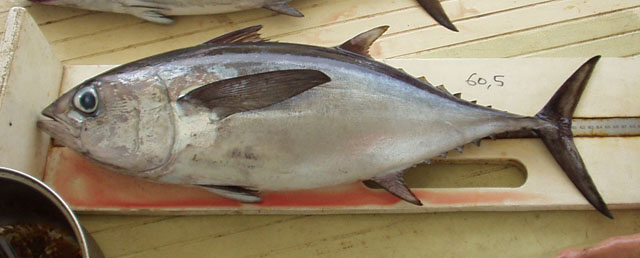| Scombridae (Mackerels, tunas, bonitos), subfamily: Scombrinae |
| 107.95 cm FL (male/unsexed); max.weight: 21 kg |
|
pelagic-oceanic; depth range - 50 m, oceanodromous |
| Western Atlantic: off Martha's Vineyard, Massachusetts south to Trinidad Island and Rio de Janeiro, Brazil (Ref. 168); including south of Brazil (Ref. 36453). Highly migratory species, Annex I of the 1982 Convention on the Law of the Sea (Ref. 26139). |
|
Dorsal spines (total): 13-13; Dorsal soft rays (total): 14-15; Anal spines: 0-0; Anal soft rays: 13-14; Vertebrae: 39-39 |
| Found in oceanic waters, sometimes not far from the coast (Ref. 13628). Forms large mixed schools with the skipjack tuna. Its spawning grounds are located well offshore. Preys on surface and deep-sea fishes, squids, amphipods, shrimps, crabs and stomatopods and decapod larvae. The largest fishery for blackfin tuna operates off the southeastern coast of Cuba and uses live-bait and pole. Utilized fresh, dried or salted, canned and frozen (Ref. 9987). |
|
(Ref. 96402)
|
| harmless |
|
Source and more info: www.fishbase.org. For personal, classroom, and other internal use only. Not for publication.
Page created by Jen, 05.08.02,
php script by kbanasihan 06/09/2010 ,
last modified by
dsantos, 20/08/10

